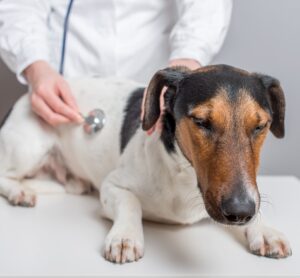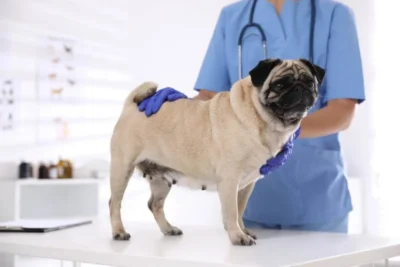Like any other animal, dogs can be susceptible to certain diseases and infections. One category of these diseases are sexually transmitted diseases (STDs), passed on through sexual contact. While the thought of a dog contracting an STD may be disturbing, it is crucial to understand that not all STDs are the same, and the risks and symptoms vary depending on the specific disease. This article will explore whether can dogs get STDS with their symptoms and treatment options.
Dogs can contract sexually transmitted diseases; studies have shown that dogs are more likely to catch STDs than humans. These infections can be passed on through sexual contact or sharing bodily fluids with another person or animal.
Dogs are omnivores, which means they eat both plants and animals. This means that if a dog gets an STD from eating an infected squirrel or rabbit, it could pass it on to other animals and humans—in fact, according to one study, up to 95% of dogs may carry at least one type of flea-borne disease.
Several different types of STDs can affect your dog. Some are bacterial, while others are caused by viruses.
The most common STD in dogs is Brucellosis, caused by the bacteria Brucella canis. It is mainly spread through breeding practices and causes infertility, abortion, and epididymitis in males.
Dogs can also be infected with Trichomoniasis, a parasitic infection that affects the reproductive system and can cause vaginitis and urethritis. Other less common STDs in dogs include Campylobacteriosis and leptospirosis.
Most STDs mentioned above are primarily seen in dogs bred in unhygienic conditions or in breeding operations that do not follow appropriate health protocols. Responsible breeding practices and regular checkups with a veterinarian can help reduce the risk of STDs in dogs.
While it’s less common than in humans, Dog STDs can be severe and even life-threatening, so it is vital to take appropriate precautions to protect your pet by maintaining a hygienic environment and having regular checkups with a veterinarian.
Can dogs get STDS?

Dogs can get sexually transmitted diseases (STDs). However, it is essential to note that dogs do not contract STDs the same way as humans, and the transmission methods are often different. In dogs, STDs are typically caused by bacterial or viral infections and are spread through breeding and contact with infected bodily fluids or tissues.
Dogs catch bites from other animals that carry fleas or ticks. For example, ticks may carry Lyme disease (spread by deer ticks). Ticks can also transmit Rocky Mountain spotted fever and tularemia (which is spread by black-legged ticks).
Other ways that dogs can get STDs to include:
- Licking their genitals.
- Sharing food with other pets.
- Playing with other pets’ excretions.
- Biting at flowers or grass.
- Licking themselves after they’ve been outside.
- Being around other dogs who have already been exposed to an infected animal, even if the infected animal has died.
Some of the most common STDs in dogs include Brucellosis, Trichomoniasis, and Campylobacteriosis. Brucellosis is a bacterial infection that can spread through breeding and contact with infected bodily fluids.
Symptoms of Brucellosis in dogs include fever, weight loss, and inflammation of the reproductive organs. This infection can also cause infertility in both males and females.
Trichomoniasis is a parasitic infection that is primarily spread through breeding. Symptoms of Trichomoniasis in dogs include inflammation of the genitals, discharge from the genitals, and difficulty urinating.
Campylobacteriosis is a bacterial infection primarily spread through contact with infected bodily fluids or tissues. Symptoms of Campylobacteriosis in dogs can include diarrhea, vomiting, and abdominal pain.
Can dogs get sexually transmitted diseases?
Dogs can contract sexually transmitted diseases, though it is relatively rare compared to other health issues that dogs may face. These diseases are primarily spread through sexual contact with an infected animal, and common STDs include Brucellosis and Trichomoniasis.
These diseases can cause serious health problems, such as infertility and spontaneous abortions, so it is vital for dog owners to be aware of the potential risks and to take appropriate precautions to protect their pets.
Proper breeding practices and regular checkups with a veterinarian can help reduce the risk of STDs in dogs. If you suspect that your dog may have an STD, it’s essential to seek help from a veterinarian immediately to prevent further spread and to give your dog the best chance for recovery.
What are the most common STDs in dogs?

Some of the most common STDs in dogs include Brucellosis, Trichomoniasis, and Campylobacteriosis. Brucellosis is a bacterial infection that spreads through breeding and contact with infected bodily fluids. Symptoms of Brucellosis in dogs include fever, weight loss, and inflammation of the reproductive organs.
Trichomoniasis is a parasitic infection that is primarily spread through breeding. Symptoms of Trichomoniasis in dogs include inflammation of the genitals, discharge from the genitals, and difficulty urinating.
Campylobacteriosis is a bacterial infection that is primarily spread through contact with infected bodily fluids or tissues, symptoms of Campylobacteriosis in dogs can include diarrhea, vomiting, and abdominal pain. It’s important to note that not all STDs in dogs present apparent symptoms, and in some cases, it might require specific testing to identify them.
How do dogs get STDs?
Dogs can contract sexually transmitted diseases (STDs) in various ways, although the transmission methods are often different than humans. One of the most common ways that dogs get STDs is through breeding. Certain bacterial and viral infections can be spread through contact with infected bodily fluids, such as semen and vaginal secretions.
In addition, some STDs can be spread through contact with infected tissues. Dogs can also be infected by exposure to an infected animal or by contact with an infected object, such as contaminated bedding.
Another way is through non-intact dogs. For example, dogs that have not been neutered or spayed have a higher risk of contracting STDs because they are more likely to have contact with other dogs that may be infected.
Not all dogs show symptoms of STDs, so regular checkups and testing are essential to identify and prevent the spread of these diseases.
How can I prevent my dog from getting STDs?

You can take several steps to help prevent your dog from contracting sexually transmitted diseases (STDs). One of the most effective ways to prevent STDs in dogs is to have your dog spayed or neutered. This will significantly reduce their chances of coming into contact with other infected dogs.
Another way is to keep your dog from roaming freely and coming in contact with other dogs that may be infected. Regular checkups and testing can help identify any potential infections and allow for prompt treatment.
It’s also essential to keep your dog’s environment clean and to avoid sharing items, such as water and food bowls, with other dogs. Vaccines for certain dog STDs like Brucellosis are available and can be administered by a veterinarian.
Additionally, if you plan to breed your dog, it is crucial to have them tested for STDs before breeding and to only breed with healthy dogs. Choosing a reputable breeder, who has a protocol for testing the breeding dogs for STDs, can also help reduce the chances of your dog contracting STDs.
Can STDs be transmitted from dogs to humans?
In some cases, certain sexually transmitted diseases (STDs) can be transmitted from dogs to humans, a condition known as zoonosis. However, it is essential to note that the risk of transmission is generally low and that most STDs that affect dogs cannot be transmitted to humans.
Brucellosis caused by Brucella Canis is an example of a dog STD that can be transmitted to humans. However, it is a rare condition, primarily seen in people who are occupationally exposed to infected dogs, such as veterinarians, breeders, and laboratory workers. The symptoms of Brucellosis in humans can include fever, muscle and joint pain, and headaches.
Campylobacteriosis caused by Campylobacter can also be transmitted to humans, primarily through contact with infected feces or consuming contaminated food or water. It is essential to practice good hygiene, such as washing your hands thoroughly after handling dogs or coming into contact with their bodily fluids or feces, to help prevent transmission.
Additionally, consulting a veterinarian for regular checkups, testing, and any doubts is the best way to help ensure your pet’s health and protect yourself and other family members.
What are the symptoms of STDs in dogs?

There are several sexually transmitted diseases (STDs) that can affect dogs, each with its own set of symptoms. Some common symptoms of STDs in dogs include:
- Discharge from the genitals: Dogs with STDs may have discharge from the penis or vagina that is discolored or has an unusual odor.
- Inflammation or irritation of the genitals: Dogs with STDs may lick or bite at their genitals frequently, indicating they are uncomfortable or itchy.
- Difficulty urinating or defecating: Some STDs can cause inflammation of the urethra or anus, making it difficult for dogs to urinate or defecate.
- Loss of appetite or energy: STDs can cause dogs to feel unwell and lethargic, leading to a loss of appetite and energy.
How is an STD diagnosed in a dog?
Diagnosing sexually transmitted diseases (STDs) in dogs typically involves a combination of physical examination, laboratory testing, and a review of the dog’s medical history. The first step in diagnosing an STD in a dog is to note any physical symptoms or abnormal behavior the dog displays.
A veterinarian will perform a physical examination to check for signs of infection or inflammation in the dog’s reproductive organs and take samples of any discharge or fluids for laboratory testing.
These samples may be sent to a laboratory for analysis of cells and DNA and culture if needed. Blood tests, including a serological test to detect specific antibodies, are also required. Imaging techniques like X-ray or ultrasonography can also diagnose and confirm infections.
The treatment of STDs in dogs will depend on the specific condition and the severity of the infection. Therefore, an accurate diagnosis is crucial for providing appropriate care and treatment.
What is the treatment for STDs in dogs?

The treatment for STDs in dogs will vary depending on the specific disease. Some common treatments include:
- Antibiotics: Many bacterial STDs can be treated with antibiotics. Your veterinarian will likely prescribe a specific antibiotic based on the type of bacteria causing the infection.
- Antiviral medications: Some viral STDs can be treated with antiviral drugs. However, these medications may not be as effective as antibiotics and may be unable to eliminate the virus from the dog‘s system.
- Surgical intervention: In some cases, surgical intervention may be necessary to treat an STD. For example, if a dog has a tumor caused by an STD, the tumor may need to be removed.
In addition to treating the specific disease, it is vital to prevent STDs among dogs. This may include using barriers such as condoms during breeding and practicing good hygiene when handling dogs with STDs.
Can STDs in dogs be cured?
Bacterial STDs, such as Brucella canis and Campylobacteriosis, can be effectively treated with antibiotics and eliminate the symptoms. However, it is essential to note that the dog will remain a carrier of the disease and may be able to spread it to other dogs.
Viral STDs, such as Canine Herpes Virus and Canine Coronavirus, cannot be completely cured, and the virus will remain in the dog’s system for the rest of its life, even with antiviral treatment. They can manage symptoms, but the virus will stay in their system, meaning they risk experiencing flare-ups or viral shedding that could infect other dogs.
In some cases, such as with some cancers caused by STDs, it may be possible to cure the disease through surgery or radiation therapy. However, the best way to prevent the spread of STDs among dogs is to practice good hygiene and take precautions to avoid infection.
Is it common for dogs to get STDs?

It is not typical for dogs to get sexually transmitted diseases (STDs). However, the prevalence of STDs in dogs can vary depending on the condition, lifestyle, and environment. For example, dogs that are not spayed or neutered and have frequent contact with other dogs that may be infected have a higher risk of contracting STDs.
Certain breeds of dogs may also be more prone to certain types of STDs, such as Bulldogs, who are more prone to developing skin fold pyoderma due to skin folds and excess skin. Certain STDs in dogs, like Brucellosis, are considered to be relatively rare and might be found in only small numbers of dogs, whereas others, like Trichomoniasis, are more common.
How do I protect my dog from getting STDs at the dog park or from other dogs?
There are several ways to protect your dog from getting STDs at the dog park or from other dogs:
- Vaccinations: Vaccinating your dog against certain bacterial and viral STDs can help to protect them from infection. Talk to your veterinarian about which vaccinations are recommended for your dog based on its breed, age, and lifestyle.
- Avoid close contact with other dogs: If your dog still needs to be fully vaccinated, it is best to avoid close contact with other dogs until they have completed their vaccinations.
- Supervise your dog while interacting with other dogs: While at the dog park or other areas where dogs gather, it’s essential to supervise your dog and be aware of the behavior of other dogs.
- Avoid dog parks with no oversight or sanitation: Research the reputation of dog parks before visiting to ensure that the area is safe, sanitized, and well-maintained.
- Do not let your dog share food and water dishes: Prevent your dog from sharing food and water dishes with other dogs, as this is a common way for STDs to spread.
- Clean your dog after a walk or visit the dog park: clean your dog’s paws, fur, and mouth before returning home to prevent any pathogens from entering the house or spreading among resident pets.
Conclusion
Conclusively the subject of can dogs get STDS is that dogs can be susceptible to certain sexually transmitted diseases (STDs), just like any other animal. These STDs are caused by various bacterial and viral infections and can be spread through breeding and contact with infected bodily fluids or tissues.
Some of the most common STDs in dogs include Brucellosis, Trichomoniasis, and Campylobacteriosis. These STDs can cause symptoms such as fever, weight loss, inflammation of the reproductive organs, difficulty urinating, and others. However, it is essential to note that not all dogs show symptoms of STDs, and not all STDs are present in the same way in dogs as in humans.
Therefore, regular checkups and testing are essential to identify and prevent the spread of these diseases. The best way to protect your dog from STDs is to have them spayed or neutered, keep them from roaming freely and coming in contact with other dogs that may be infected, and consult a veterinarian for regular checkups, testing, and any doubts.
Additionally, it’s also essential to practice good hygiene, such as washing your hands thoroughly after handling dogs or coming into contact with their bodily fluids or feces, to help prevent the transmission of these diseases to humans.


